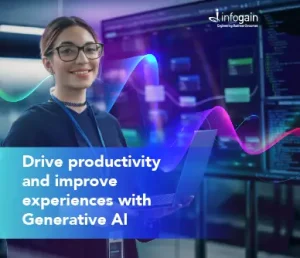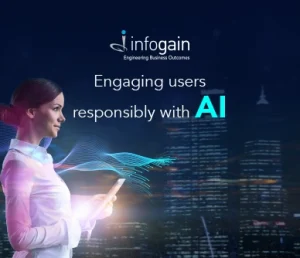- Posted on : October 10, 2017
-
- Industry : Digital and High Technology
- Service : Business Intelligence & Reporting
- Type: News

Virtual reality, Artificial Intelligence, Augmented Reality and virtual reality are becoming growing examples of cutting edge applied technologies. In an exclusive conversation with Ramesh Subramanian, CTO, Infogain, Faiz Askari of SMEStreet explored latest trends in the uprising segment.
We are witnessing a major transformation in almost every field. In the area of technology, this transformation is happening in the form of intelligence and experiential learning. Virtual reality, Artificial Intelligence, Augmented Reality and virtual reality are becoming growing examples of cutting edge applied technologies. In an exclusive conversation with Ramesh Subramanian, CTO, Infogain, Faiz Askari of SMEStreet explored latest trends in the uprising segment of Machine Learning, Artificial Intelligence, IoT and Virtual Reality.
The edited excerpts:
Faiz Askari: How are enterprises today adopting Machine Learning and Artificial Intelligence?
Ramesh Subramanian: Machine Learning and AI has advanced significantly in the past few years and enterprises are constantly working on models that would help in analysing large volumes of structured and unstructured data type with the ultimate goal to improve business performance. According to a latest Gartner prediction Artificial intelligence will be the top investment priority for 30% CIOs by 2020 as AI technologies will be virtually pervasive in almost every new software product and service.Effective adoption is still in the nascent stage though, with evolving problem definitions, drivers, data sets and ROI expectations. ML is at a similar point on its adoption curve as the internet was in the late 1990s or cloud computing was in the mid-2000s. These disruptive technologies hold tremendous potential but enterprises need to step with caution and should have a well-though out, strategic approach before adopting it.
Faiz Askari: Enterprises has seen tremendous changes in the last few years from adoption SaaS to Mobile and Analytics. How do you foresee the market changing with automation and intelligence?
Ramesh Subramanian: The adoption of SaaS, Mobility and Analytics are a part of the trend towards “personalization” of business models driven by IT, where segments-of-one are the goal and the power of search and selection at the hands of the customer are practically infinite. Automation and Intelligence are intuitively the next steps in this trend, and we foresee these techniques becoming ubiquitous in the next year or two.
Today, Machine Learning and AI is heralding new algorithms, applications, and frameworks bringing greater predictive accuracy and value to enterprise data. With the availability of huge data sets and the low cost of computing and storage, enterprises now are keen on exploring new technologies that can redefine their processes, bring in innovations and helps them to stay ahead of the curve. Automation is being implemented across industries, ranging from transportation and utilities and manufacturing and different sectors have their own sets of business benefits. Different industries will have to implement and apply automation in different ways to achieve the desired results.Some use cases for Automation and Intelligence transcend industry verticals- such as Chatbots for assisting with customer/ employee interactions, Advanced Search for better leverage of knowledge capital, Robotic Process Automation to integrate and streamline business processes; in more detail,for a Retail business, automation and intelligencecan help in Predictive Inventory Planning, for a Travel business it can streamline traffic patterns and congestion management. Similarly for Healthcare it can help in real time patient monitoring and prognosis, and for a Manufacturing business, it can help in predictive maintenance and improved collaborative planning.
Faiz Askari: What kind of caution or preparedness is required by enterprises to adopt these technologies?
Ramesh Subramanian: Enterprises are bound to face some challenges with Automation and Intelligence. On the one hand are the well-known risks to jobs arising out of more decisions being made automatically by machines, and improved digitization from process automation.
On the other hand, evidence suggests that early ML/AI pilots are unlikely to produce the dramatic results that technology enthusiasts predict. For example, early efforts of companies developing chatbots for Facebook’s Messenger platform saw 70% failure rates in handling user requests. Firms need to understand that this technologyrepresents a completely different paradigm and requires a well-though out, strategic approach to adopting it.
The following steps/ approach can be leveraged to effectively operationalise enterprise ML/AI programs-
- Prepare groundwork for adoption– Machine learning based use-cases cannot be implemented overnight. Preparation for leveraging ML and AI technologies must be planned just as well as implementation of the technology itself. The business challenge needs to be articulated clearly and data required must be identified, prepared and manged on an ongoing basis. Identify the features required and engineer the architecture for building the same.
- Build Required Capabilities- Hiring the required skills is essential for deploying sophisticated ML and AI programs. This is probably the biggest challenge today, given the high demand for such skills but severe shortage in supply. Skills that are essential for ML include- modern architecture and technology skills, data science and experienced domain skills to understand complexity and requirements of implementing an industry use- cases.
- Plan for Deployment at scale- Too many ML/AI projects fail today when implemented at scale, even though they might have had a successful PoC. Hence the planning for deployment must take into the account the scale for implementation- it should be well defined mathematically and the ontology that is developed must be robust at scale. The algorithms need to be trained adequately by ensuring availability of large and clean data sets.
Faiz Askari: What kind of investments are required by enterprises?
Ramesh Subramanian: Automation is the way forward and investments are increasing sharply particularly by tech giants like Apple, Amazon or Google who are investing in billions in R&D and in acquiring AI based start-ups. According to a recent report there are 2,200+ Artificial Intelligence start-ups, and well over 50% have emerged in just the last two years. However the areas are yet to be explored for commercial benefit and in a recent McKinsey survey of around 3000 businesses across the globe, business leaders are still uncertain about the benefits from their investments in AI. It is predicted that AI adoption for enterprise will remain slow in 2017.
Faiz Askari: How is Infogain helping enterprises? What kind of solutions are you bringing to the market?
Ramesh Subramanian: Infogain is at the forefront of implementing some aspects of the Automation and Intelligence technology spectrum. We help our customers automate and digitize business processes across countries and business groups, resulting in visible and significant benefits to their bottom lines.
We help our customers get a perspective on value of such technology to their businesses, identification of use-cases within their range of activities, and implementing pilots to review outcomes and caveats. This phase of ‘digital’ consulting enables our customers to plan strategically and adopt these technologies to the extent and within constraints as relevant to their businesses. While this still gives some exemplary results to our customers, such a methodical approach allows them to approach the business case without too many surprises.
We have helped our customers to make quicker and better decisions based on image analysis and monitoring- including video monitoring, in an automated manner; these customers span industries as wide as Finance, Insurance, Healthcare, Manufacturing, Travel, etc. Some of these use cases involve a combination of cutting-edge technologies, such as IoT, remote sensing and imagery, blockchains etc. alongside Automation and Intelligence to deliver value that was impossible in an earlier era.
We also actively induct partners and alliances into our portfolio, to ensure the entrepreneurial technology initiatives are made fully available to our customers.
— The writer is VP, HR, Infogain
News Originally Posted on: SME STREET






